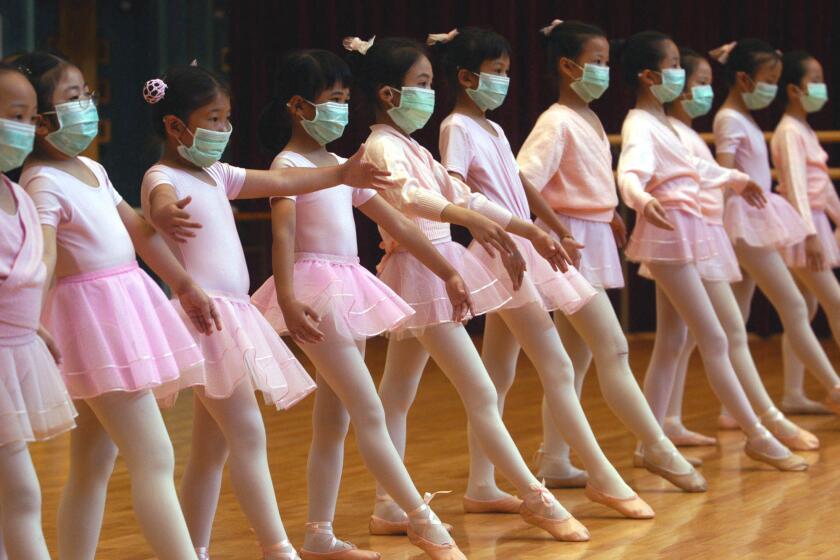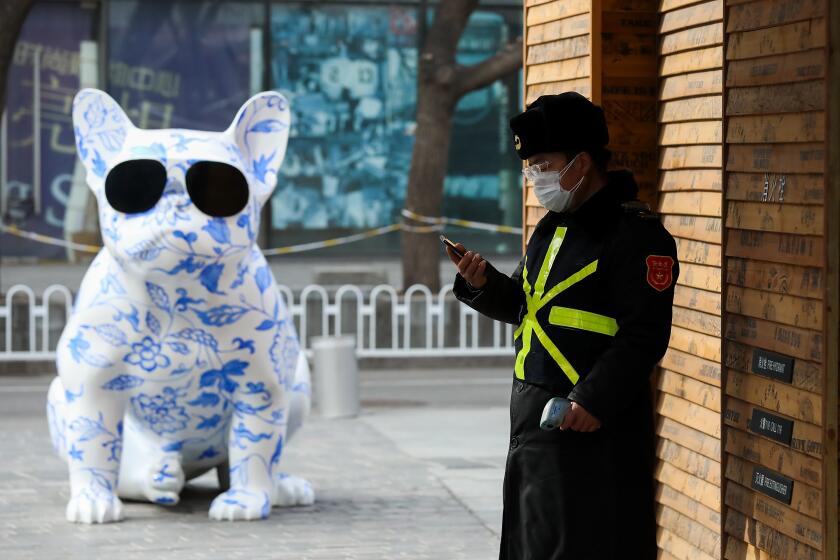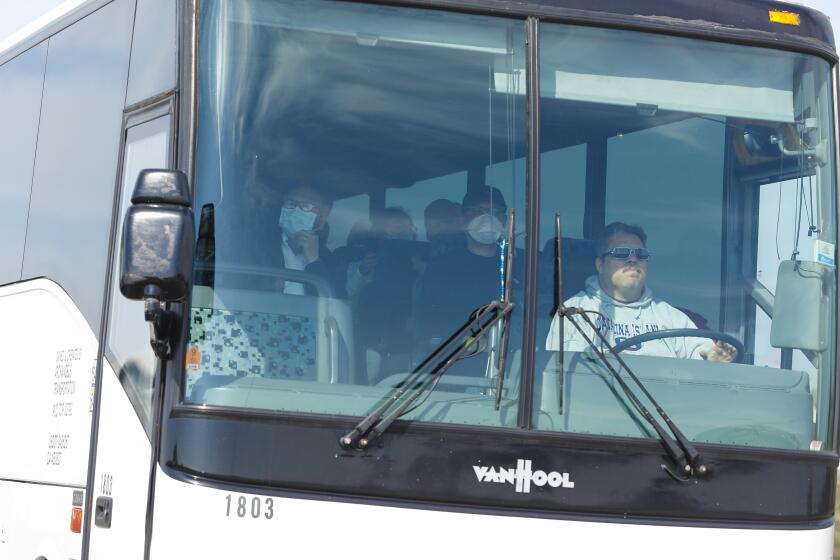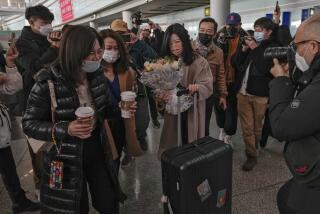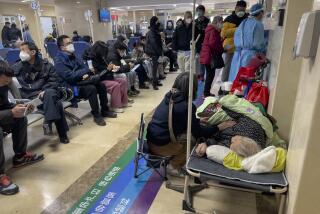China’s virus center vows to find every infected person as reported cases fall
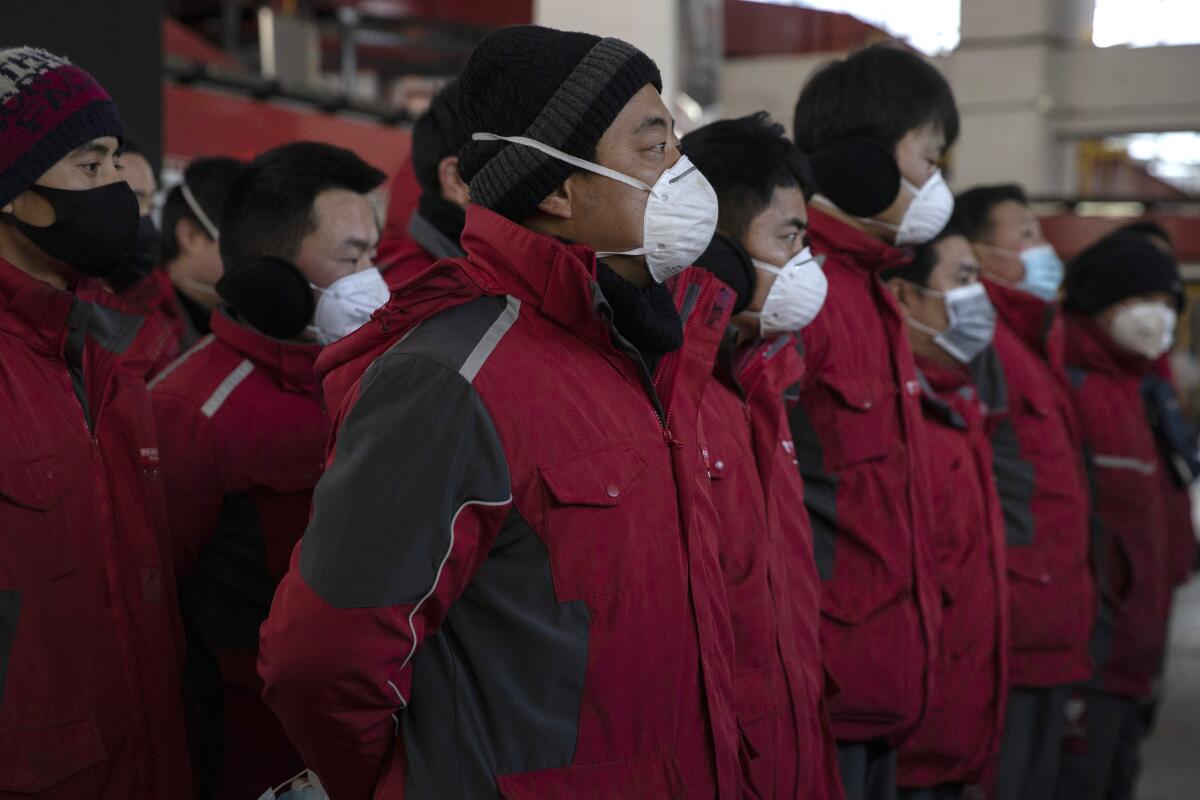
- Share via
BEIJING — Inspectors clad in protective suits went door-to-door Wednesday in the epicenter of China’s viral outbreak on a mission to find every infected person in the city that has suffered the most from an epidemic that is showing possible signs of waning, with new cases falling for a second day.
Wuhan, where the new form of coronavirus emerged, is on the final day of a campaign to root out anyone with symptoms who may have been missed so far.
“This must be taken seriously,” said Wang Zhonglin, the city’s newly minted Communist Party secretary. “If a single new case is found [after Wednesday], the district leaders will be held responsible.”
His remarks were published on Hubei’s provincial website along with the declaration: “If the masses cannot mobilize, it’s impossible to fight a people’s war.”
Mainland China reported 136 additional deaths on Wednesday. While the overall spread of the COVID-19 illness has been slowing, the situation remains severe in Hubei province, which has Wuhan as its capital. Infections in Hubei constitute more than 80% of the country’s 74,188 total cases and 95% of its 2,006 deaths, according to data from China’s National Health Commission. Over 75,000 cases have been reported worldwide.
The containment of the 2003 SARS outbreak is considered one of the biggest public health victories in recent years. Stopping the new coronavirus, known as COVID-19, will probably be much harder.
Cities in Hubei with a combined population of more than 60 million have been under lockdown since the Lunar New Year holiday last month, usually the busiest time of the year for travel. Authorities put a halt to nearly all transportation and movement except for quarantine efforts, medical care and delivery of food and basic necessities. “Wartime” measures were implemented in some places where residents were prevented from leaving their apartments altogether.
The stringent measures have followed public fury over Hubei authorities’ handling of the epidemic when it began in December. The risk of human-to-human transmission was downplayed, and doctors who tried to warn the public were reprimanded by authorities. Wuhan residents reported overcrowding in hospitals and futile attempts to seek treatment.
Many countries have also set up border screenings, and airlines canceled flights to and from China to prevent further spread of the disease, which has been detected in some two dozen countries and caused almost 1,000 confirmed cases outside mainland China. Six deaths have been reported outside the mainland, in Hong Kong, Taiwan, Japan, the Philippines and France.
China’s top diplomat, on a visit to Laos, assured his Southeast Asian counterparts that the situation in Hubei province and Wuhan has “been brought under effective control.”
Foreign Minister Wang Yi spoke to diplomats from the Assn. of Southeast Asian Nations ahead of an emergency meeting on Thursday to discuss the disease. Six countries in the 10-nation bloc have confirmed cases of the new virus.
In Hong Kong, the Hospital Authority reported a 70-year-old man had succumbed to the virus, the city’s second death out of 65 confirmed cases. The victim had underlying conditions including diabetes and hypertension, said Dr. Lau Ka-hin, an authority official.
Passengers began leaving the Diamond Princess cruise ship after a much-criticized two-week on-board quarantine in Japan ended on Wednesday, with 79 more virus cases confirmed for a total of 621 — the most in any place outside of China.
South Korea evacuated six South Koreans and a Japanese family member from the ship, and they began an additional 14-day quarantine Wednesday. More than 300 American passengers were evacuated earlier and are quarantined in the United States, including at least 14 who had tested positive for the virus.
Liu Zhiming is at least the seventh health worker to die of the COVID-19 disease among the more than 1,700 doctors and nurses who have become sick.
On Tuesday, the U.S. said the more than 100 American passengers who stayed on the ship or were hospitalized in Japan would have to wait another two weeks before they could return to the U.S.
Passengers from another cruise ship, the Westerdam, that docked last week in Cambodia have tested negative for the virus, Cambodia’s Health Ministry announced Wednesday.
Several hundred of the 700 passengers aboard the Westerdam had already left the country when it was discovered that one passenger had been infected, leading to the quarantine of those still in Cambodia. Authorities in several countries were tracking the passengers who already left.
“Prevention and control work is at a critical time,” Chinese President Xi Jinping said during a phone call Tuesday evening with British Prime Minister Boris Johnson, according to Chinese state media.
Likewise, United Nations Secretary-General Antonio Guterres told the Associated Press in an interview in Lahore, Pakistan, that the virus outbreak “is not out of control, but it is a very dangerous situation.” He said that “the risks are enormous and we need to be prepared worldwide for that.”
Those released Tuesday are among 167 from Wuhan and Hubei Province who arrived Feb. 5
Outside Hubei, other localities have imposed quarantine measures to varying degrees. Residential neighborhoods in Beijing have placed limits on the number of people per household who can go out, and those who do must carry exit-entry cards. In Shanghai, police detained a man for 10 days for repeatedly leaving the house and taking public transportation when he was supposed to be under quarantine at home.
Despite such warnings, Beijing was showing signs of coming back to life this week, with road traffic at around a quarter of usual, up from virtually nothing a week ago. While most restaurants, stores and office buildings remained closed, some had reopened. People entering the capital were required to have their temperatures taken and register their contact information.
The country may postpone its biggest political meeting of the year, the annual congress due to start in March, to avoid having people travel to Beijing while the virus is still spreading. One of the automotive industry’s biggest events, China’s biannual auto show, was postponed, and many sports and entertainment events have been delayed or canceled.
The U.S. also upgraded its travel advisory for China to Level 4, telling its citizens not to travel to the country and advising those currently in China to attempt to depart by commercial means.
“In the event that the situation further deteriorates, the ability of the U.S. Embassy and Consulates to provide assistance to U.S. nationals within China may be limited. The United States is not offering chartered evacuation flights from China,” the notice said.
“We strongly urge U.S. citizens remaining in China to stay home as much as possible and limit contact with others, including large gatherings. Consider stocking up on food and other supplies to limit movement outside the home,” the notice said. The U.S. previously flew out scores of its citizens on charter flights from Wuhan but does not have any further plans to do so, it said.
Also on Wednesday, China said it was expelling three Wall Street Journal reporters over the headline for an opinion column about the current virus outbreak in China that called the country the “Real Sick Man of Asia.”
Long sensitive to its portrayal in global media, China has been pushing a narrative of transparency and tight control over the current outbreak, while emphasizing the sacrifices made by its health workers and ordinary citizens.
More to Read
Sign up for Essential California
The most important California stories and recommendations in your inbox every morning.
You may occasionally receive promotional content from the Los Angeles Times.
